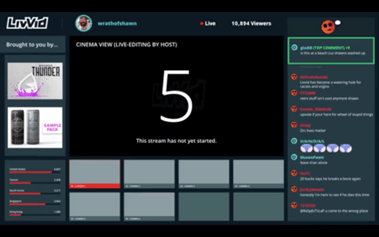Heather Roberts
In Joseph and Vanessa Winter’s horror comedy Deadstream (2022), disgraced influencer Shawn Ruddy (Joseph Winter) attempts to resuscitate his career by livestreaming his stay at a haunted house. The film is part of a newer, more Generation Z-friendly iteration of found footage horror that explores the alarming lengths influencers can go to in their pursuit of online fame. Deadstream mimics conventions, particularly claims of authenticity, in both found footage and influencer culture to satirize influencers and the culture that incentivizes and rewards their behaviour. Thematically, Shawn’s fall from internet stardom mirror influencers like Logan Paul who have similarly filmed and uploaded controversial videos online without considering the consequences, calling into question the content that we post and watch on the internet.
I use Paul as an example in this paper both because his personality and vlogging style represent the archetypal influencer that Shawn satirizes, and also because elements of Shawn’s livestream closely resemble Paul’s 2017 Japanese suicide forest video. Paul is famous for making prank-style vlogs (i.e., video logs) on YouTube, where his channel has 23.6 million followers, and he embodies the sarcastic, cocksure attitude that many influencers adopt. Shawn operates a similar channel called “Wrath of Shawn” in which he faces his fears in a series of moronic stunt vlogs, such as being smuggled across the Mexico-United States border in the trunk of a car.
In December 2017, Paul posted a video titled “We found a body in the Japanese suicide forest…,” in which he callously displayed a dead body he and his friends discovered in Japan’s Aokigahara forest, a well-known location for suicides (Romano). The video, which Paul took down the next day, was met with mass public outrage, prompting multiple apologies from Paul on social media; however, he lost countless sponsors and followers, and subsequently took a month-long hiatus from vlogging. Like Paul, Shawn posted an ethically dubious video and lost all his sponsors and followers. Deadstream chronicles Shawn’s return to the internet as he spends a night in Death Manor, which is reportedly haunted by several ghosts. The parallel between the two influencers is most apparent in the chosen stunt for Shawn’s livestream because one of the house’s ghosts is Mildred Pratt, a suicide victim. Both Paul’s Aokigahara video and Shawn’s livestream exploit tragic deaths for entertainment, relying on the appeal of an authentic supernatural experience to attract viewers.
The inherent truth claims in found footage make it particularly well suited to analyze and critique influencer culture because they are both dependent on the perception of truthfulness or realness for audience engagement. Influencers like Paul earn millions of dollars a year by amassing large numbers of viewers and monetizing their attention, creating vlogs that influence viewers to consume products. In a culture that emphasizes authenticity as a way to connect with viewers, influencer videos with the most outlandish and “real” content are rewarded with the most views and, therefore, the most money (Brooks et al. 530).
Similarly, one of the key pleasures of found footage is a blurring of the lines between reality and fantasy (Heller-Nicholas 4), which occurs when films are presented as authentic through an established system of formal conventions. In a guest post for Horror Homeroom, Brian Fanelli argues that using vlogging as a narratological and stylistic tool modernizes the found footage genre, bringing it into conversation with contemporary mediamaking practices. The emergence of social media and influencer cultures offers a new direction for found footage to explore, where authenticity is created through the adoption of vlogging aesthetics and customs. Stylistically, films like Deadstream, Spree (2020), and Dashcam (2021) imitate these conventions by mimicking social media/streaming platform interfaces, using voiceover narration, and showing viewers’ comments as they watch in real time. This new group of found footage films emulates the experience of watching a vlog or livestream online, replicating signs of authenticity that speak to a younger, social media-savvy generation of found footage fans.
Deadstream adopts the language of vlogging to satirize influencer culture and its customs. In fact, much of the film’s playfulness comes from moments in which these conventions are made ridiculous. At the beginning of the film, Shawn’s livestream is preceded by a view of the LivVid platform with a timer counting down to the broadcast’s start. The platform’s name, meant to be short for “Live Video,” also doubles for “livid,” a witty wordplay that speaks to the inflammatory nature of Shawn’s content and its effect on viewers. The interface displays metrics for the number of viewers and their geographical distribution, and a scrolling panel of viewers’ predominantly sarcastic comments. The comments panel serves as another sign of authenticity, indicating the immediacy of watching a livestream in real time as viewers react to the footage.
The comments, which also appear throughout the film as Shawn randomly checks in with his audience, are mainly insults targeted at Shawn and are riddled with the spelling and grammatical errors that typically plague internet comment sections (e.g., the top-rated comment reads “is this at a beach cuz shawns washed up”). The comments play a significant role in advancing the film’s plot; many commenters express disbelief that the stream is real, goading Shawn into increasingly dangerous situations to prove that the images are not staged or doctored. While the interactions between Shawn and his viewers provide comedic opportunities (e.g., he makes fun of a commenter’s spelling who taunts that “hanted houses are overdone”), these exchanges also highlight problems with viewership and the demand for authentic content in influencer culture. Shawn is so desperate to regain his fame and popularity that he endangers his own life to appease his audience. His situation suggests that viewers and the pressure they exert on influencers are also responsible when influencers cross a line with their content, such as Paul’s Aokigahara video.
Apart from referencing new trends in found footage, Deadstream also makes light of the overlaps between conventional found footage forms that are typically used to create authenticity and influencer vlogging, creating humorous intertextual references. Title cards that often appear at the beginning of found footage films to provide context for the footage, most notably in The Blair Witch Project (1999), are hilariously turned into a commemorative t-shirt for Shawn’s followers to purchase. Commodification is a pillar of influencer culture as the core revenue stream of an influencer is convincing their viewers to consume products. In fact, many influencers develop their own products or merchandise, which they then promote to their followers through social media (e.g., Emma Chamberlain’s company Chamberlain Coffee, PewDiePie’s video game PewDiePie: Legend of the Brofist). Paul promotes his Maverick clothing line on his channel by wearing pieces from the collection, asking viewers to purchase his clothing, and including a link to the online store in most of his vlogs. Shawn’s merchandising strategy is a cheeky dig at commodification practices in influencer culture that rely on authenticity to sell products. By turning title cards, one of the key tropes used to convey realness in found footage films, into a t-shirt, he literally turns authenticity into a consumable commodity.
Another convention that Deadstream references is the shaky, handheld recording style that traditionally characterizes found footage films like Blair Witch. The style is also seen in many vlogs and livestreams that follow influencers as they perform pranks or go about their daily lives, giving the footage a feeling of documentary-like authenticity. Shawn achieves this effect through GoPro cameras that he wears on his body and mounts in various rooms around the house. The practice becomes ridiculous as Shawn places more and more cameras, including one on the end of a spear that he uses to attack Mildred, and another on her head, which he labels “Mildead Cam.” Shawn’s cameras poke fun at customs in influencer culture where anything and everything is fodder for entertainment on the internet. Paul’s channel is flooded with inane videos that cover a wide range of topics from the mundane to the absurd, including his first tattoo, his friend’s skin tag removal procedure, and his outlandish stunts. Here, the comedy builds throughout the film as Shawn continues to add cameras in his effort to capture every event from every angle.
Here is also where the film’s true horror manifests and where Deadstream’s parallel to Paul is the most evident. Once again, the emphasis on realness and delivering the most authentic content in influencer videos is a key consideration. In the introduction to the Aokigahara video, Paul states that “This is not clickbait. This is the most real vlog I’ve ever posted on this channel” (“SUICIDE FOREST VIDEO” 0:08-0:11), claiming that the video marks a moment in YouTube history. The demand to create increasingly real content in order to attract and amuse viewers perpetuates what Romano calls a “film first and think later” mentality, which feeds off of the “toxic YouTube prank culture” that incentivizes these kinds of shock and awe videos. Even though Paul claimed that he did not post the Aokigahara video for the views (it bears noting that the video was not monetized) but rather to raise awareness for suicide prevention (“Dear Internet”), the tone of the video is no different from other prank or joke videos on his channel, and the fact still stands that he used another person’s death as entertainment on the internet. Overall, the video reveals serious problems with not only online viewership as it amassed over 6 million views before it was taken down, but also the type of content that is posted online, which prioritizes authenticity over humanity (Meyer).
Shawn’s choice of location for his livestream clearly references Paul’s video. He knowingly visits a house where a suicide and other horrible deaths have occurred and broadcasts the experience online for others’ pleasure. He mimics Paul’s words by repeatedly telling viewers that he offers them the most “cinematic” experience on the internet, using the authenticity and novelty of his content as bait to draw in viewers. Satirical elements in the film that are seemingly humorous on the surface add gravity to the scenario by highlighting problematic conventions in influencer vlogging. For example, Shawn emulates the sarcastic persona that many influencers effect in their vlogs, often saying or doing inappropriate things, particularly in his treatment of death and suicide. He plays a tape of spooky music as he investigates the hallway where Mildred hung herself and makes a joke about dead babies in a room where children reportedly died. Paul similarly received scathing criticism for laughing and joking while standing beside the suicide victim’s body in the Aokigahara video (Meyer). As in Paul’s video, Shawn’s attempts to undercut serious or grim subject matter with humour demonstrate a lack of humanity that is truly horrifying to watch. Influencers, the film argues, are so desperate to become rich and famous by posting real content on the internet, that they do not stop to question if they should.
Even more horrific than the initial scandal videos that both Paul and Shawn posted are the events that follow. The lapse in judgement and subsequent mea culpa videos are sadly a common occurrence in influencer culture (e.g., PewDiePie, Laura Lee, and James Charles have all posted apology videos in response to their bad behaviour), but Deadstream focuses on what comes after. Do influencers learn from their mistakes? The film says, “no.” Shawn’s ingenious comeback idea is to provoke the spirit of a suicide victim and broadcast it live on the internet. He shows no remorse for his previous actions, complaining about how they have impacted him, he repeats the same callous behaviours, and, at one point, he states that he only apologized “because he had to” (52:24-52:25). As a social commentary, the film pessimistically shows that influencers are destined to repeat their mistakes. Using Paul as an example certainly supports this conclusion. In the first vlog he posted after the Aokigahara controversy, Paul focuses on the negative effects he has experienced, calling out YouTube for cutting his Adsense revenue in half (“LOGAN PAUL IS BACK”), while his subsequent videos continue to toe the line between humour and horror.
Deadstream’s ending is equally as grim. The only way for Shawn to defeat Mildred is to take her place, becoming one of the spirits tied to the house. Mildred is a kind of influencer herself by literally influencing the house’s visitors to kill themselves in order to amass a ghostly audience for her poetry readings (i.e., her content). Shawn’s absorption into the house, then, symbolizes a never-ending chain in which influencers beget influencers, offering a foreboding view that influencers like Shawn and Paul will be lasting fixtures in contemporary culture. Furthermore, Deadstream suggests that influencers are inseparable from the spectacles that they seek to document. Shawn’s actions throughout his online career and the film are horrific, but when he becomes one of Death Manor’s ghosts, he becomes the horror. Paul’s video similarly demonstrates that his quest for the most authentic content is just as horrific as finding a dead body in the woods. In the end, influencers themselves are the true horror.
Works Cited
Brooks, Gillian, et al. “Influencer Celebrification: How Social Media Influencers Acquire Celebrity Capital.” Journal of Advertising, vol. 50, no. 5, 2021, pp. 528-47.
Deadstream. Directed by Joseph Winter and Vanessa Winter, performances by Joseph Winter and Melanie Stone, Shudder, 2022.
Fanelli, Brian. “Followed: A Clever Use of Found Footage and a Smart Critique of Influencer Culture.” Horror Homeroom, 26 June 2020.
Heller-Nicholas, Alexandra. Found Footage Horror Films: Fear and the Appearance of Reality. McFarland, 2014.
Meyer, Robinson. “The Social-Media Star and the Suicide.” The Atlantic, 2 Jan. 2018.
Paul, Logan. “LOGAN PAUL IS BACK!” YouTube, 4 Feb. 2018.
Paul, Logan. “LOGAN PAUL SUICIDE FOREST VIDEO.” Internet Archive, 4 Jan. 2018.
Paul, Logan. “@loganpaulvlogs.” YouTube.
Romano, Aja. “Logan Paul, and the Toxic YouTube Prank Culture That Created Him, Explained.” Vox, 3 Jan. 2018.










